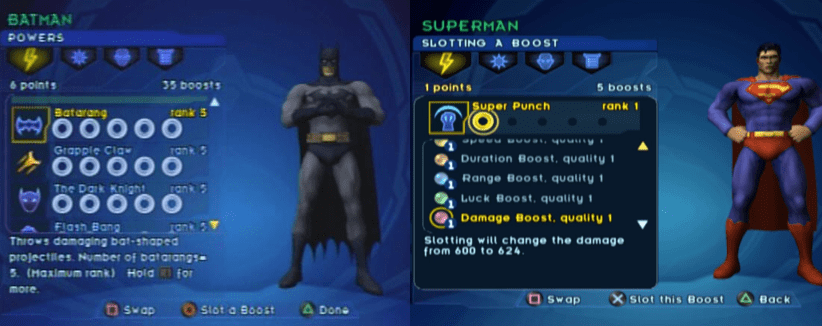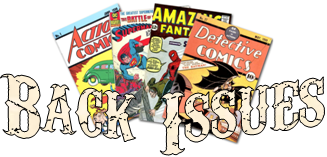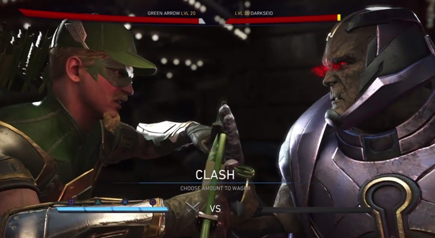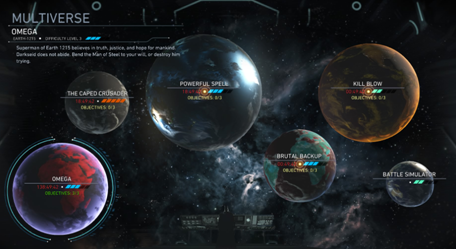To celebrate the release of Justice League (Snyder/Whedon, 2017), DC Comics named November 18 “Justice League Day”. Sadly, this clashes with something else I have planned for that date this year but, setting aside all the drama surrounding that movie, this still provides a perfect excuse to dedicating some time to talking about DC’s premier superhero team, which set the standard for super teams in comics by bringing together DC’s most powerful heroes.
Released: 22 November 2006
Developer: Snowblind Studios
Also Available For: Nintendo DS, PlayStation Portable, and Xbox
The Background:
After coming together in November 1959, the Justice League of America (JLA) quickly became one of DC Comic’s best-selling titles. This shouldn’t be entirely surprising considering the team came to be comprised of DC’s most popular characters: Clark Kent/Superman, Bruce Wayne/Batman, Diana Prince/Wonder Woman, Hal Jordan/Green Lantern, Arthur Curry/Aquaman, Barry Allan/The Flash, and J’onn J’onzz (also known as “John Jones”)/Martian Manhunter. The team saw many members come and go over the years but was a constant staple of DC’s library of comic books and soon expanded into other media. Interestingly, the Justice League’s success hasn’t always resulted in the best videogames, though, meaning developers Snowblind Studios faced a bit of an uphill battle right from the start when creating Justice League Heroes. Built out of a modified engine of their critically acclaimed title Baldur’s Gate: Dark Alliance (ibid, 2001), the developers ending up removing features from that game and engine to focus on extending the length of Justice League Heroes, which has more than a few similarities to Marvel: Ultimate Alliance (Raven Software/Barking Lizards Technologies, 2006), which released about a month earlier. Reviews of the game were mixed across platforms, though, and the game was generally regarded as a bit of a mediocre and mindless beat-‘em-up.
The Plot:
The Earth is under attack from the robot forces of Brainiac, who has coerced many of the world’s most notorious supervillains into helping him consolidate the power afforded to him by a mysterious box from the stars. In response, the world’s greatest heroes, the Justice League, leap into action and team up to oppose Brainiac’s plot in a globe-trotting adventure that requires all of their individual abilities and skills.
Gameplay:
Justice League Heroes is a top-down action brawler in which you (and either another player or a computer-controlled partner) battle through a number of recognisable locations from the DC universe as various members of the Justice League. The game’s story is split into a number of missions that see two members of the Justice League teaming up at any one time; a second, human player can join the game at any point from the pause menu, a solo player can freely switch between the two heroes at will by pressing up on the directional pad (D-pad), and you’ll also be tasked with assembling one or more custom teams of two characters later in the story but you’ll never get the opportunity to switch out characters completely or replay missions with different characters. Gameplay in Justice League Heroes revolves almost entirely around beating up endless hoards of robots and aliens and solving some very light puzzles; characters can jump with a press of the Triangle button (and double jump or fly/glide with subsequent presses depending on who you’re playing as), attack with strong and fast attacks with Circle and X, respectively, and can grab enemies or objects with Square and block incoming attacks by holding R1. By entering different button presses (X, X, O, for example), players can pull off simple combo attacks to take out enemies but there are, sadly, no team up attacks to be found here.

While every character controls the same except for their ability to fly or glide, each one is made slightly different from the other through their individual superpowers. By pressing L1 and either Triangle, Square, Circle, or X, players can pull off their character’s signature super moves as long as they have enough energy stored up. This allows you to blast enemies with Superman’s heat vision, for example, or turn them into rabbits with Zatanna Zatara’s magic, or smash them with John Stewart/Green Lantern’s massive sledgehammer. Pressing L1 and R1 will see each character (with some exceptions) pull off a more powerful super special attack which, again, varies per character; Superman, for example, will become stronger while Batman unleashes a swarm of bats to damage foes and Martian Manhunter briefly becomes intangible and invisible. They’re all pretty useful and different enough in their own way, with most characters having a projectile of some sort, a move to boost their attack or speed, or being able to stun or otherwise incapacitate enemies and you’ll sometimes (very rarely) need to use a specific character’s superpowers to bypass obstacles in order to progress. When playing alone, you can also issue simple commands to your partner using the D-pad; this allows you to increase the aggressiveness of their attack or have them focus on defence, which can be useful when teamed with Zatanna as she’s able to heal all team members.

Overall, I found the computer to be surprisingly useful and competent; if your partner gets downed, however, you’ll have to rush in to revive them but the game automatically revives any downed characters when you reach one of its numerous checkpoints and enemies will often drop health-restoring orbs to keep you ticking over. Furthermore, if you’re able to attack enemies without taking damage, you’ll build up your “Heroic Meter”, which will increase your damage output until you get hit, and you can alter the difficulty of the game and its enemies by selecting different difficulty settings from the main menu. Despite the game being extremely linear, the developers included a helpful mini map, which you can expand by pressing in the right analogue stick. This isn’t always necessary but, as many of the environments are rather drab, grey, similar, and somewhat labyrinthine at times, it’s a welcome addition to keep you on track even during the game’s shorter and more straightforward missions. Unfortunately, the top-down view can be rather restrictive at times; many areas are filled with debris or obstructions and it always seems like you can only see just enough of the area, which can lead to enemies catching you off guard or hiding behind parts of the environment with no way to see them as they don’t show up on the map. It’s not all mindless brawling, either; occasionally, you’ll be tasked with rescuing a number of civilians or hostages, faced with a time limit, or directed to activate consoles to lower barriers in order to progress. As alluded to earlier, these very rarely require you to use the Flash’s superspeed or the Martian Manhunter’s intangibility to get past obstacles and stop fans, lower energy barriers, or deactivate Kryptonite hazards so that you can progress further. Sometimes you’ll also need to destroy a wall or use a character’s flight to progress across rooftops and, in the final portion of the game, you’ll not only have to protect Superman as he smashes through Darkseid’s fortress but you’ll also be faced with an extremely frustrating and confusing teleport puzzle that was the only time I had to actively look up a solution online.
Graphics and Sound:
Thanks to its zoomed out, top-down perspective, Justice League Heroes is, largely, able to get away with hiding any inconsistencies and defects in its in-game character models. Since you never really see your characters up close, the developers can have them talk and drop hints and quips without really needing to animate their mouths and the simple beat-‘em-up action of the game means that characters just need to look somewhat decent when they throw punches, grab cars, or blast out energy beams. And, for the most part, they do; there’s some neat little touches here and there (like Martian Manhunter being able to transform into his true, more monstrous form and the Flash being accompanied by a speed force double and lightning) and characters are always talking so you know when you need to drop or combine Boosts or have a vague idea of how the story is progressing.
Sadly, enemies and environments don’t always live up to the colourful and eye-catching depiction of the titular Justice League. It takes a long time for you to battle anything other than Brainiac’s generic robots or explore areas beyond the wrecked streets of Metropolis or the cold, grey corridors of Scientific and Technological Advanced Research Laboratories (S.T.A.R. Labs) and the like. Eventually, though, you do venture into more visually unique environments like the subways, a honeycomb and sap-encrusted hive, the ruins of J’onn’s civilisation on Mars, Gorilla City, a Lovecraftian dimension populated by strange rock creatures and living tentacles, and a version of Apokolips created on Earth but there’s very little variety offered in terms of the enemies or puzzles and hazards you face as you progress. No matter where you are, it’s the same thing every time: defeat all enemies, maybe activate a console, and reach the end of the stage.
The bulk of the game’s story (which is about as generic as you can get for a Justice League videogame) is conveyed through CG cutscenes featuring the traditional rubbery-looking graphics you’d expect from a PlayStation 2 game. I did notice some slowdown when there was a lot happening onscreen and, in terms of music and sound, the game is very unimpressive; the voice cast isn’t even the same one as in the popular Justice League animated series (2001 to 2006) and, while I love me some Ron Perlman, he just sounds bored whenever his Batman speaks (I’m also not really a fan of how often Batman is shown in broad daylight).
Enemies and Bosses:
As I’ve mentioned a bit already, you’ll wade through numerous disposable enemies in your mission to stop Brainiac and his lieutenants but none of them are particularly interesting. You’ll battle robots of varying sizes, humanoid wasps, White Martians on the surface of Mars, Gorilla Grodd’s gorilla forces, and Parademons but, once you’ve fought one lot of enemies, you’ve fought them all as they all feature regular foot soldiers who shoot at you and both flying and bigger variants that can take a bit more punishment. Honestly, the only enemies I even remotely found interesting were the weird crab and toad-like enemies you face later in the game and the instances where you battle Brainiac’s skull robots and failed clones of Doomsday because they at least looked a little different.

Before you can defeat Brainiac, you’ll have to battle a number of bosses; some of these are simply bigger, more dangerous versions of enemies you’ve already fought or Brainiac’s more deadly robots and duplicates. You’ll battle a Brainiac duplicate in S.T.A.R. Labs, for example, but this fight isn’t just about throwing punches. Instead, you have to activate consoles to lower barriers and rescue the scientists against a time limit all while “Brainiac” fires lasers and energy blasts at you. You’ll also encounter some of the more obscure villains from DC Comics’ gallery; Queen Bee has established a hive in the Metropolis subway and is transforming civilians into monstrous insect hybrids and, when you confront her in her throne room, she shields herself from your attacks and rains missiles into the arena that make the floor sticky. She’s only vulnerable when she leaves her throne but your window of opportunity to attack her is hampered somewhat by her minions, her energy blasts, and her tendency to dart across the screen like a madwoman. You’ll also butt heads with the Key, of all people. Like with Brainiac’s duplicate, you have to rescue some scientists against a time limit during this battle but the Key proves to be a particularly elusive and versatile enemy as he teleports around the place and causes hazards to blast out from his dimensional portals.
Similarly, when fighting Doctor Louise Lincoln/Killer Frost, you’re given one minute and forty seconds to destroy three missiles (and five seconds to get away from each before they explode) in addition to battling her and her icy minions. Killer Frost can conjure grunts, form ice shields, and blast at you with ice and icicles, all of which can make battling her quite tricky and annoying as your attentions are constantly divided. After reaching the core of a pyramid-like structure on Mars, Superman and the Martian Manhunter have to battle the White Martian leader; this guy is also accompanied by disposable White Martian grunts and you’re tasked with activating four nearby power nodes to defeat him. Things get noticeably more interesting when the Justice League splits into teams; while one team flies through the upper atmosphere destroying generators on invading spacecraft, another destroys power turbines in Gorilla City and gets into a confrontation with Gorilla Grodd. Grodd primarily uses his staff to attack and is joined not only by an inexhaustible supply of gorilla minions but also a series of energy-firing turrets so it’s probably best to try and keep your distance and stay on the move to emerge victorious in this fight. After battling their own security system in their Watchtower space station, the Justice League then faces off with a larger, more powerful Doomsday clone that, unlike pretty much every other boss in the game, boils down to a question of who can attack hardest and fastest rather than distracting you with tricks and puzzles.
Eventually, you’ll breach Brainiac’s main base and be forced to battle his three robot guardians before you confront him; Brainiac is completely protected by an energy shield and is only vulnerable when he rises from his throne and only for a brief window of time. He also likes to teleport you to the far end of the arena, where you’re forced to destroy the generators that power his barriers and take out some minions just to get back up to him, so it’s more a question of patience than anything. As you might have guessed, the moment you defeat Brainiac he is immediately usurped by Darkseid, who teleports you away to a hellish dimension and then converts Earth into a new Apokolips. You’ll need to assemble two teams of four to confront Darkseid, who stomps around his throne room creating shockwaves and plumes of fire along the ground and blasting at you with his powerful Omega Beams. Being an all-powerful New God, his health also regenerates over time, meaning you’ll have to keep pummelling him again and again in order to keep him down. This was, honestly, a bit of a confusing fight; you can grab the “Apokolips Hypercube” nearby, which seems to weaken him and make him vulnerable to your attacks but I also found myself running around with it in my hands and not doing any damage to Darkseid at all and then he just suddenly succumbed to my attacks and was defeated.
Power-Ups and Bonuses:
In almost every area in the game, you’ll find objects that you can grab and use as weapons; some of these are limited to the specifics of your character, though, meaning that you won’t be lifting cars over your head as, say, Oliver Queen/Green Arrow, for example. Still, you can grab post boxes and parking meters and cars and such to bash over enemy’s heads, which adds a bit of variety to the otherwise relentless combat. You can also pick up temporary power-ups throughout each environment to give yourself and your team mate a bit of a power boost so it can be worth exploring a little bit and smashing destructible objects wherever you see them.
The game also features some light role-playing elements; as you defeat enemies, you’ll gain experience points (EXP) and level-up once you’ve earned enough EXP. This will increase your stats and abilities but you also earn Skill Points that you can spend upgrading your character’s superpowers up to five different ranks to increase their effectiveness and duration. Additionally, enemies will also drop various “Boosts” that you can equip at any time; you can also combine Boosts together to create new, more powerful Boosts and equipping these will also boost your superpowers, increase your damage output or defence, or increase the range and duration of your attacks.
Additional Features:
Although the game is extremely linear, there are often some rewards to be found through exploration; generally, these will just be stockpiles of health, energy, or Boosts but you’ll also find be civilians in danger who need rescuing who will drop “Justice League Shields”. Shields can also be found by destroying parts of the environment and you can spend these on skins and additional characters. While you can select any of the unlockable costumes at any time, they won’t actually load until you reach the next checkpoint/area and you can only select to play as the unlocked characters when the game allows you to pick a team of your own. The skins available are quite impressive, though; while not every character gets a skin, some offer bonus boosts to your stats and there’s some fan favourites available here, like Superman’s black suit, Batman’s traditional blue and grey suit, and the Jay Garrick version of the Flash. You can also unlock the likes of Green Arrow, Aquaman (sporting his water hand), Helena Bertinelli/The Huntress, and what I assume is the Kendra Saunders version of Hawkgirl.
You’ll notice, however, that neither Huntress, Aquaman, or Hawkgirl have an L1+R1 special move, though I’m not entirely sure why. You can also unlock Hal Jordan and Kyle Rayner but, despite these two being separate characters, they control exactly the same as John Stewart, which is a little disappointing; none of the unlockable characters have alternate costumes either, which is a bit of a missed opportunity in my book. Initially, you can select from Easy, Normal, or Hard difficulties but you’ll unlock two more difficulty levels (Elite and Superhero, on which most enemies will kill you in one hit) and be given the option of starting the game over from the beginning with all of the upgrades and EXP you amassed during your run upon completing the game. Sadly, there’s no option to free play any mission with any character, no versus mode, and no option to play online or with more than one other player but there are a number of cheats that you can activate from the pause menu to give yourself invincibility, infinite energy, all upgrades, and a bunch of Shields to quickly unlock all of the game’s skins and characters.
The Summary:
Justice League Heroes isn’t going to really offer you anything you can’t get from any other mindless beat-‘em-up; the stages and enemy designs can be very bland and boring and there really isn’t much asked of you other than to mash the same buttons over and over and activate a few consoles. Still, as a fan of beat-‘em-ups and brawlers, I found Justice League Heroes to be a pretty decent way of spending an afternoon; there’s a lot of characters available to you and I like that the story mixes the teams up quite often and allows you to put together your own teams, and the game is probably even more enjoyable with a friend to play with. There could have been more options and unlockables available (such as free play mode, maybe some challenges, and a boss rush), the music and graphics can stutter a bit, and the game is awash with dark, boring, grey locations, but, as a repetitive brawler featuring the Justice League, it’s decent enough, though probably not very appealing to those that aren’t fans of the source material and characters.
My Rating:
Could Be Better
Have you ever played Justice League Heroes? If so, what did you think to it? Were you disappointed by the game’s presentation, selection of villains, and the inability to freely pick characters on the go? Which of the available characters was your favourite and preferred duo? What genre do you think would work for a future Justice League videogame? What version of the Justice League is your favourite and are there any DC superheroes you’d like to see added to the team someday? How are you celebrating Justice League Day this year? Whatever your thoughts on Justice League Heroes, and the Justice League in general, feel free to drop a comment below.































You must be logged in to post a comment.